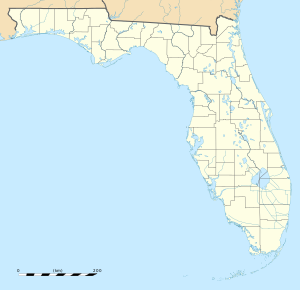Buckingham Army Airfield
| Buckingham Army Airfield | |
|---|---|
| Part of Army Air Forces Training Command | |
| Fort Myers, Florida | |

Buckingham Army Airfield, Florida - 1944
|
|
| Coordinates | 26°38′36″N 081°42′37″W / 26.64333°N 81.71028°WCoordinates: 26°38′36″N 081°42′37″W / 26.64333°N 81.71028°W |
| Site history | |
| Built | 1942 |
| Built by | United States Air Force |
| In use | 1942-1945 |
| Battles/wars | World War II |
Buckingham Army Airfield is an inactive United States Army Air Forces base, approximately 10 miles east of Fort Myers, Florida. It was active during World War II as an Army Air Forces Training Command airfield. It was closed on 30 September 1945, prior to the establishment of the United States Air Force as an independent service two years later in 1947. Part of the airfield is now in the Wild Turkey Strand Preserve.
Buckingham Army Airfield was a training base, established in 1942 under AAF Eastern Flying Training Command, and when active, was the largest airfield in the State of Florida.
Its primary mission during World War II was to train the aerial gunners who would defend bombers. In 1942 and 1943, most American fighter planes didn't have the range needed to keep up with the bombers. This would leave the bombers and their crews unprotected on lengthy flights over enemy territory. Sitting in turrets and standing behind openings in fuselage of the bomber, it was their job to shoot down attacking aircraft was critical to the United States' success in both the European and Pacific theaters.
Besides the gunnery students, Buckingham AAF was also the primary training center for gunnery instructors at the Army's other flexible gunnery schools, the term meaning that the aerial gunner had a flexible mount at the station or in the turret of the aircraft, rather than the fixed aerial gun of fighter aircraft.
The field's beginnings was a land purchase in 1941 by a group of Fort Myers and Lee County, Florida officials, and then leased the land back to the War Department for the establishment of an Army Air Corps airfield. At the time of its purchase, the land was used for cattle grazing. The new base would create thousands of jobs, increase property values, and bring a business boom to the local economy. Construction of the airfield began in February 1942 at a cost of $10 million on a total of 7,000 acres (28 km2) of swamp land, which had to be drained with an extensive system of newly constructed drainage canals, by itself an impressive engineering achievement. By mid-June 1942, construction of the airfield was underway and by August, almost 500 buildings were under construction.
...
Wikipedia

